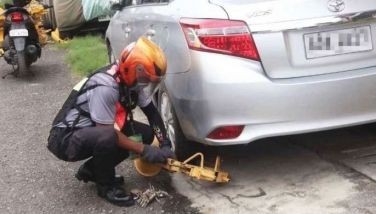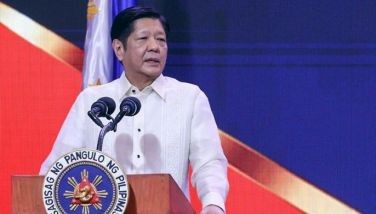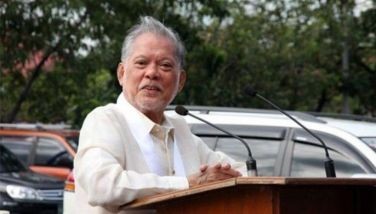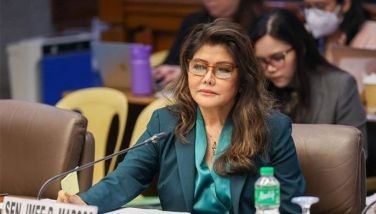BASAHIN: Talumpati ni Aquino sa APEC CEO summit
MANILA, Philippines -- Nagbigay ng talumpati ngayong Lunes si Pangulong Benigno Aquino III sa pagbubukas ng Asia-Pacific Economic Cooperation Chief Executive Officers (APEC CEO) Summit sa lungsod ng Makati.
LIVE UPDATES: APEC 2015 meetings in Manila
PInagtuunan ng pansin ni Aquino ang kahalagahan ng inclusive growth o ang paglago ng ekonomiya na mararamdaman ng lahat.
Ibinahagi ng Pangulo kung paano niya pinamunuan ang bansa sa nakalipas na limang taon at ito ay ang pagsugpo sa katiwalian bilang uanng hakbang tungo sa pagbabago.
Nabanggit niya kung paano pinanagot sa batas ang mga nanamantala sa kapagyarihan.
Narito ang kaniyang buong talumpati sa harap ng mga delegado ng APEC CEO summit:
Some of you in this room may be familiar with the roots of the healthy Philippine democracy of today. In 1986, millions of our people gathered in EDSA—our capital city’s most prominent avenue—and other cities throughout the nation to overthrow a dictator, who had for too long subjected our country to his tyranny and oppression. People armed only with rosaries, good intentions, and belief in their countrymen stood up to tanks, artillery, and planes. This was the miracle of EDSA, which made possible that which was impossible, and returned democracy through People Power. After fourteen years of Martial Law, our people were successful in lifting my mother into the Presidency to lead the rebuilding of our nation. That era—from the dictatorship which began when I was 12, up until the end of my mother’s presidency when I was 32—undoubtedly shaped many of the viewpoints I hold today. I will never forget one particular instance, when my family was in exile in Boston, and I asked my father: “If we are in the right, why are we the ones in exile?” He responded with a question of his own: “How can those who cannot even eat, think of concepts such as freedom and dignity? The first freedom is the freedom from hunger.” That is the first that has to be won.
I share my father’s words today because what we will speak of in this summit—and in the meetings that will occur in the days to come—is deeply personal to me. We will have important conversations about how we can free our people from the oppression of poverty, and how to empower them to take part in sustainable economic growth. Today, perhaps I can tell you about the Philippine story: what we have done to achieve large-scale transformation.
I recall a very early meeting I had with my Cabinet, in which we discussed why the poverty rate hardly moved over the past decade—or what I sometimes refer to as a “lost decade.” The numbers were alarming: Income growth was low, and inequality was at incredibly high levels, in terms of access to employment and social development opportunities, particularly in health, education, and social protection. All this, despite relatively consistent economic growth.
When one thinks about it, it is quite sad. If ten years ago, if my predecessor had done what we’re doing now, I can only imagine where the Philippines would be. Of course, I am also aware that past is past, and nothing you can do in the present or the future will change it. Nevertheless, remembering the past revitalizes us—and energizes us to make up for lost time.
We resolved that this sort of trickle down economics was not the way forward, and that the only real growth is that which is felt by the many. Thus, inclusive growth became the north star of our national policy—growth that truly helps each and every Filipino lift themselves up from poverty, and play a meaningful role in continuing our country’s growth story.
We spoke of the methods we would employ. We knew we had to craft and relentlessly pursue a holistic and cohesive national strategy—one that can systematically respond to every debilitating aspect of poverty, with the belief that this good governance is good economics.
One of the first things we looked at was whether we were making the most of the scarce resources we had at our disposal. This is why, from day one, the question we have always sought to answer while discussing any program or project has been: How does this benefit the Filipino people? We took a budgeting system compromised by leakages and corruption, and instituted in its place zero-based budgeting. Through this system, we reviewed all the items in the budget to find out what was achieving its purpose and what wasn’t. For those that weren’t, we either changed the program or removed it completely, to make absolutely certain that every peso of taxpayer money is spent with the people foremost in our minds. We also followed the principle of bottom-up budgeting: we reached out to communities, believing that they, more than anyone else, know their own needs. We took advantage of technology to implement mechanisms to aid in transparency and accountability, through websites called Budget ng Bayan and Pera ng Bayan, which mean The People’s Budget and The People’s Money, respectively. These gave our citizens greater power to monitor our budget, and also to report individuals suspected of wrongdoing.
We plugged leaks throughout the bureaucracy, and we did not shy away from confronting the most complex and crippling problem of our nation, namely, corruption. Over the last five years, we cracked down on all those proven to have engaged in wrongdoing. Now, a former President is under hospital arrest after being charged with plunder. The former Chief Justice who had no compunctions about being selective about implementing the law was removed through impeachment, after it was revealed that he violated our laws by failing to declare over 98 percent of his assets as mandated by our Constitution. Well-known Senators have been arrested for their alleged involvement in a scam of massive proportions. We have likewise filed 581 cases against tax evaders and smugglers, who owe the Filipino people billions of pesos in taxes. And might I point out that these only cover a fraction of our anti-corruption efforts.
These efforts, among countless others, naturally freed up or helped increase the resources we had at our disposal; the only question was where to allocate it. We did not think twice about our decision. We invested it in our greatest resource: our people. That is why, from 2010 to 2015, our Social Welfare and Development Budget increased sevenfold, our Department of Education’s Budget essentially doubled, and our Technical Education and Skills Development Authority’s Budget increased by 84 percent. Might I emphasize that we did all this, and more, without raising any taxes, apart from the sin tax, the proceeds of which went to expanding medical services for our people.
But we didn’t simply throw money at the problem. We followed a thorough strategy to respond to all aspects of poverty, and to give our people a legitimate chance to retake authorship of their own destinies. Perhaps I can give you a brief walkthrough of our approach.
We invested in upgrading our educational infrastructure. Within our first three and a half years in office, for instance, we ended an inherited backlog of 66,800 classrooms, along with inherited shortages in seats and textbooks. We reformed our basic education cycle to conform to global standards, and to give our children ample time to digest their lessons and maximize their learning.
We also knew, however, that even though elementary and high school education are supposed to be free in the Philippines, some of our countrymen didn’t have the wherewithal for transportation, or for pocket money, that would allow them to capitalize on this free education. Some were in such dire poverty that their bodies could not stand the rigors of schooling. This is why we undertook the large-scale expansion of our conditional cash transfer program. It gives cash grants to poor households, as long as their children go to school, are vaccinated, amongst other conditions. This responds to the twin problems of families not being able to get by, and children not being able to attend school. Perhaps we can listen to one of the beneficiaries speak about the program:
[CCT VIDEO 1]
From June 2010, the number of beneficiaries of this program has gone from less than 800,000 households to 4.4 million, or roughly equivalent to 22 million Filipinos. In 2014, we began including households with high school age children, because our institute of development studies conducted a study that showed that high school graduates earn 40 percent more than those who only spent some years in elementary level. While this program was designed with the long-term effects in mind, we have already enjoyed early success. In fact, this year, 333,673 CCT beneficiaries graduated from high school, 13,469 of whom graduated either with honors or other awards. I met two of these graduates, both of whom were accepted into one of our country’s most prestigious schools, the University of the Philippines; on top of that, they are taking Civil Engineering, which is a quota course. Here is one of them talking about her experience:
[CCT VIDEO 2]
I cannot overemphasize the impact of this program. The statistics reinforce my point: From 2008 to 2013, the amount of out-of-school youth in our country dropped from 2.9 million to just 1.2 million, and we expect that these numbers will improve even more. Whereas once, some of these graduates would have been subject only to the possibility of menial jobs; now, they can move up the value chain and enter more promising careers. Of course, this is the goal for most of our students—and for our citizenry at large: that they can take advantage of the growing number of opportunities in our job market, most of which require skilled labor. This is why our Technical Education and Skills Development Authority has been working closely with the private sector to design and implement courses that give our people the best chance to attain a sustainable livelihood. Simply by doing this, we raised the employment rate of our scholars from 28.5 percent to almost 70 percent under our Training for Work Scholarship Program. Perhaps the best example of this is our work with the Semiconductors and Electronics Industries in the Philippines Foundation, Inc., where our graduates posted an employment rate of 96 percent.
Apart from helping our people find long-term employment, we are also enjoying a bonus return on our investment. Think about it: For our technical educational program, government invests an average of around P7,155 for every scholar. If a graduate, for example, finds employment in the BPO sector, a conservative estimate would have him making around P234,000 annually. Assuming he receives the [maximum] tax deduction, this means his annual income tax will be P7,900. Imagine that. In less than a year, we break even. And these individual workers will not be working for only a year; they will be paying taxes until they retire, and their taxes can help create even more opportunities for other Filipinos.
The good news is: This is not the only sector where our brand of good, common sense governance has sparked a virtuous cycle of growth and inclusivity. There is also our newfound capacity to invest in infrastructure. When my term as a member of Congress began, shortly after all our economies were reeling from the Asian Financial Crisis. The situation was so dire that, each time I approached a national government department to ask for assistance for my district, their refrain was consistent: “We have no funds.”
Now, the situation is extremely different. From 1.83 percent of GDP in 2010, we have increased our infrastructure budget to 4.10 percent of a GDP that, might I emphasize, has exhibited fast-paced growth. The goal is to have this figure reach 5 percent of GDP by next year. In fact, now we have to contend with a very different problem compared to what I encountered in Congress. I am told that a lot of times we are nearing the absorptive capacity of the government to implement these infrastructure projects, which means that we need more engineers, more qualified contractors, particularly in far-flung areas, and more building materials, among others, to build the roads, airports, and seaports necessary to give rise to the connectivity we need to allow everyone to participate in our growing economy.
Indeed, our entire growth strategy hinges on the idea of empowerment. Empowered citizens, after all, are empowered consumers, whose income will go to the goods and services produced by companies. The end result: Instead of having many big fish in a very small pond, we are moving our economic ecosystem into a bigger pond, where everybody can grow and reach their full potential.
Ladies and gentlemen, I believe this is the most critical element of sustainable growth: inclusivity. If we can include our people in public life, in determining the path to our future, and in building our economy, it redounds to a more stable environment and to greater economic prosperity. In other words, it boosts our potential to levels never before seen. You have seen the transformation of our country—from being known as the Sick Man of Asia to becoming Asia’s New Darling. You have seen how our economy has become one of the fastest growing in the world, and how we have quickly risen in global measures of competitiveness. You may have even noticed the change in our people’s attitude, from being apathetic to perhaps being a little too demanding, which we believe to be healthy in a democracy, since it gives government motivation to be even more efficient. Perhaps our people’s increased participation is not too surprising, given that they have likewise seen this transformation in their lives. The initial results of our Department of Social Welfare and Development’s most recent assessment reveal that at least 1.09 million households have been lifted from poverty, which is roughly equivalent to 5.45 million Filipinos.
I share our story with you today because I believe we can do this on a regional scale; I believe if we work with each other’s economies, and if we harness the strengths of all our peoples, we can give rise not only to inclusive national economies, but to an Asia-Pacific where our citizens truly know what we talk about when we say “growth.”
I am aware that this will neither be easy nor quick, but we have reason for optimism. The more that people gain the first freedom—which is freedom from hunger—we set an environment that nurtures the growth of all the other freedoms. The leaders of our economies have gathered here under the banner of building inclusive economies, and by so doing building an inclusive world. And I believe that, if we can fully engage the private sector in this mission, offering the many benefits brought about by inclusivity, we can achieve this sooner rather than later. Together, I am confident we can author the next great chapter in the history of human civilization; as a connected, synergized Asia-Pacific, we can bring about the advent of a region—and a world—where no one is left behind.
Thank you. Good day.
- Latest




























